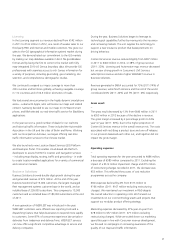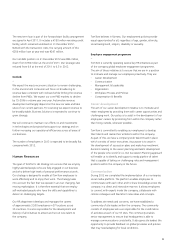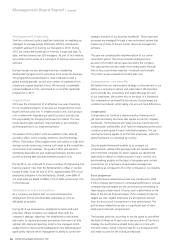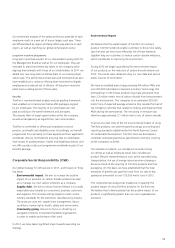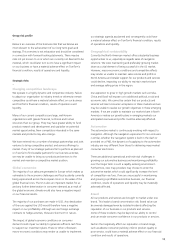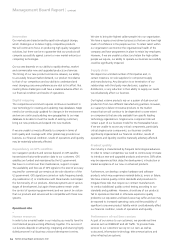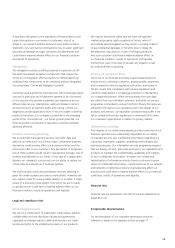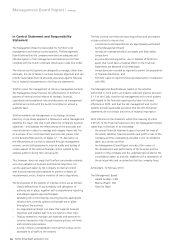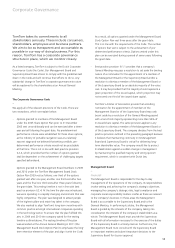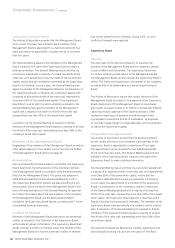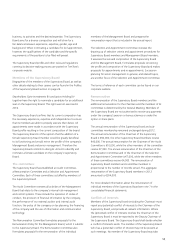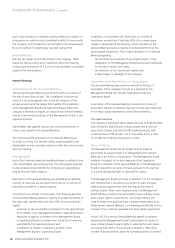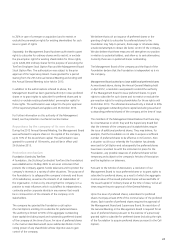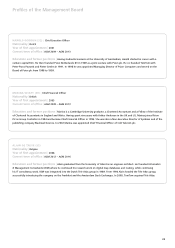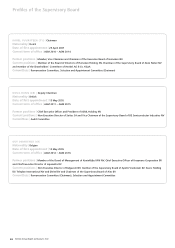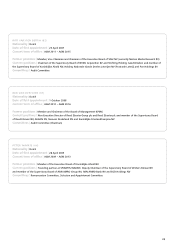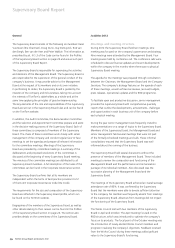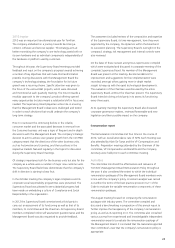TomTom 2012 Annual Report Download - page 19
Download and view the complete annual report
Please find page 19 of the 2012 TomTom annual report below. You can navigate through the pages in the report by either clicking on the pages listed below, or by using the keyword search tool below to find specific information within the annual report.17
TomTom takes its commitments to all
stakeholders seriously. These include consumers,
shareholders, employees and business partners.
We aim to be as transparent and accountable as
possible in our way of doing business. For this
reason, TomTom has a corporate governance
structure in place, which we monitor closely.
As a listed company, TomTom is subject to the Dutch Corporate
Governance Code (the Code). Our Management Board and
Supervisory Board have striven to comply with the guidelines laid
down in the Code and will continue their efforts to do so. Any
substantial change in TomTom’s corporate governance structure
will be explained to the shareholders at an Annual General
Meeting.
The Corporate Governance Code
—
We apply all of the relevant provisions of the Code. There are
two exceptions, which we explain below.
– Options granted to members of the Management Board
under the 2005 Share Option Plan prior to 31 December
2005 vest unconditionally and can be exercised after a three-
year period following the grant date. No predetermined
performance criteria were established for these share options,
as the industry of portable navigation was at a relatively
nascent stage and we believed that setting credible, pre-
determined performance criteria would not be practicable
at that time. This is not in line with best practice provision
II.2.4, which provides that the number of options granted
shall be dependent on the achievement of challenging targets
specifi ed beforehand.
Options granted to the Management Board members in 2009
and 2010 under the TomTom Management Board Stock
Option Plan 2009 vest as follows: one third of the options
granted vest after one year, another one third vest after two
years and the fi nal one third vests after three years following
the grant date. This vesting timeline is not in line with best
practice provision II.2.4. At the time the plan was introduced,
we were operating in a rapidly changing environment that was
highly competitive. The plan was designed to attract people
of the highest calibre and retain key talent in the company.
We also wanted to align TomTom’s long-term incentives with
common practice amongst international companies operating
in the technology sector. To ensure that the plan fulfi lled this
aim, in 2009 and 2010 the company opted for the vesting
timeline outlined above. The vesting timeline of the plan
was amended at the Annual General Meeting in 2011 (the
Management Board Stock Option Plan) to emphasise the long-
term retention element of the plan and align it with the Code.
As a result, all options granted under the Management Board
Stock Option Plan vest three years after the grant date.
This is in line with the requirements of the Code. The number
of options that vest is subject to the achievement of pre-
determined performance criteria. Options vested under this
plan can be exercised during a period of seven years following
the grant date.
– Best practice provision IV.1.1 provides that a company’s
General Meeting may pass a resolution to set aside the binding
nature of a nomination for the appointment of a member of
the Management Board or the Supervisory Board and/or a
resolution to dismiss a member of the Management Board or
of the Supervisory Board by an absolute majority of the votes
cast. It may be provided that this majority should represent a
given proportion of the issued capital, which proportion may
not exceed one third of the issued share capital.
TomTom’s Articles of Association provide that a binding
nomination for the appointment of members of the
Management Board or of the Supervisory Board may only
be set aside by a resolution of the General Meeting passed
with a two-thirds majority representing more than 50% of
its issued share capital. The same provision applies to any
resolution to dismiss a member of the Management Board or
of the Supervisory Board. The company deviates from the best
practice provision outlined in the preceding paragraph because
it believes that maintaining continuity in its Management
Board and Supervisory Board is critical for delivering long-
term shareholder value. The company would like to protect
its stakeholders against a sudden change in management
by maintaining the qualifi ed majority and voting quorum
requirement, which is consistent with Dutch law.
Management Board
—
General
The Management Board is responsible for the day-to-day
management of the operations of the company. Its responsibilities
involve setting and achieving the company’s strategic objectives,
managing the company’s strategic risks, legal compliance and
corporate social responsibility matters insofar as these are relevant
to the company’s business. In these areas the Management
Board is accountable to the Supervisory Board and to the
General
Meeting. In performing its duties, the Management
Board is guided
by the interests of the company, taking into
consideration the interests of the company’s stakeholders as a
whole. The Management Board must provide the Supervisory
Board with all information necessary for the exercise of the duties
of the Supervisory Board in a timely manner. Furthermore, the
Management Board must consult with the Supervisory Board
on important matters and submit important decisions to the
Supervisory Board for its prior approval.
Corporate Governance


